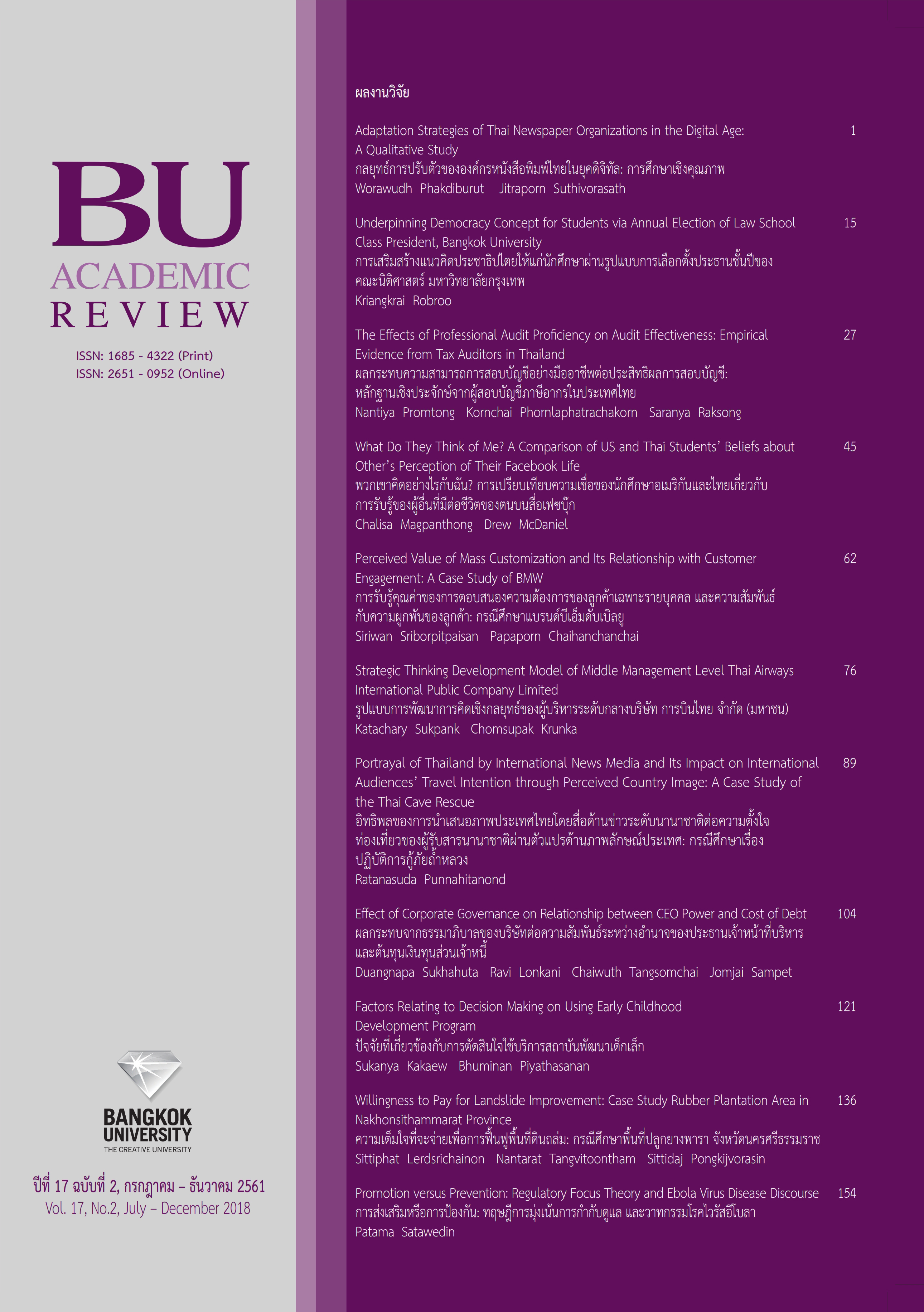Factors Relating to Decision Making on Using Early Childhood Development Program
Main Article Content
Abstract
Nowadays, to fulfill skills and knowledge for their kids, parents have been increasingly interested in using the early childhood development program. Consequently, the growth rate of the services is increasing continuously, due to high demand, a variety of programs, and high competitiveness. Hence, the early childhood development program entrepreneurs and marketers have to know deeply their consumer insights. This qualitative research aims to present the decision making on using early childhood development program by employing in-depth Interview method with several key informants, including 25 parents who has 0-6 years old kids, 5 entrepreneurs of early childhood development programs, and 5 early childhood experts. Analytic inductive was employed during qualitative data analysis. The research result showed that there are 5 factors relating to decision making on using early childhood: parent’s attitudes, characteristics of parents, characteristics of child, social norm, and perceived quality of 7Ps. Research findings of this study will advantage entrepreneurs and marketers of early childhood development programs to improve their business strategies, marketing activities, as well as service quality to meet consumers’ decision making and expectations.
Article Details
The manuscript submitted for publication must be the original version, submitted only to this particular journal with no prior acceptance for publication elsewhere in other academic journals. The manuscript must also not violate the copyright issue by means of plagiarism.
References
กนกวรรณ สมัครเขตรการ และ มารศรี สุธานิธิ. (2557). เหตุผลการตัดสินใจของผู้ปกครองในการส่งนักเรียนเข้าเรียนโรงเรียนเอกชน อำเภอบางบัวทอง จังหวัดนนทบุรี. Journal of Nakhonratchasima College, 8(1 January – June 2014), 13-23.
จันทนา สุวรรณดุก. (2552). ปัจจัยส่วนผสมทางการตลาด ที่มีผลต่อความต้องการของผู้ปกครองในการส่งบุตรหลานเข้าศึกษาต่อในโรงเรียนอนุบาลเอกชน เขตอำเภอสันทราย จังหวัดเชียงใหม่. (บริหารธุรกิจมหาบัณฑิต), มหาวิทยาลัยแม่โจ้, เชียงใหม่.
นวลประภัสสร์ เชาว์ศรีกุล และกิตติมา จึงสุวดี. (2554). ปัจจัยทางการตลาดที่มีอิทธิพลต่อการตัดสินใจใช้บริการโรงเรียนเอกชนระดับอนุบาลในเขตสำนักงานเขตพื้นที่การศึกษาประถมศึกษา อุบลราชธานี เขต 5. วารสารศรีวนาลัยวิจัย, 2(4), 70-84.
นัยพินิจ คชภักดี. (2551). พัฒนาการของสมอง (Development of the brain). กรุงเทพฯ: มหาวิทยาลัยมหิดล.
โนรี คาวิชิต และ นันทิยา น้อยจันทร์. (2558). การศึกษาการตัดสินใจเลือกสถานศึกษาให้บุตรหลานของผู้ปกครองนักเรียนโรงเรียนเทศบาลวัดสิงห์สถิต จังหวัดชัยนาท. วารสารวิชาการเครือข่ายบัณฑิตศึกษามหาวิทยาลัยราชภัฏภาคเหนือ, 5(8), หน้า 25-44.
ประกาศคณะกรรมการส่งเสริมการศึกษาเอกชน. (2558, 8 ธันวาคม). ราชกิจจานุเบกษา. เล่ม 132 หน้า 7-8.
ประชาชาติธุรกิจออนไลน์. (2556). "ตลาดเด็ก"สวนศก.โตทุกเซ็กเมนต์ สินค้ารุมชิง4หมื่นล.-ค่ายทีวีผุดช่องรับโฆษณาพุ่ง. สืบค้น 22 กุมภาพันธ์ 2561, จาก https://www.prachachat.net/news_detail.php?newsid=1380855070
พลนิกร สุภาภรณ์. (2548). พฤติกรรมผู้บริโภค =: Consumer behavior. กรุงเทพ: บริษัท โฮลิสติก พับลิชชิ่ง จำกัด.
พลอยปภัส เสนานุช. (2553). ส่วนประสมทางการตลาดบริการที่มีอิทธิพลในการเลือกศูนย์พัฒนาเด็กเล็กของผู้ปกครองในเขตอำเภอด่านซ้าย จังหวัดเลย. (บริหารธุรกิจมหาบัณฑิต), มหาวิทยาลัยราชภัฏอุบลราชธานี, อุบลราชธานี.
เพาเวอร์ ไทม์ มีเดีย. (2554). ชิจิดะ สถาบันพัฒนาศักยภาพการใช้สมองเด็ก ระดับพรีเมี่ยมจากญี่ปุ่น. สืบค้น 20 มิถุนายน 2561, จาก https://www.newsdataonline.com/index.php?option=com_content&view=article&id
แม่น้องเล็ก. (2559). พ่อแม่รังแกฉัน ผลสำรวจค่านิยมยอดฮิตของพ่อแม่ยุคดิจิตอล. สืบค้น 8 กุมภาพันธ์ 2561, จาก https://www.amarinbabyandkids.com/parenting/toddler/toddler-care/abk-poll/2/
วรรณ์วรีย์ จันทร์ฉายรัศมี. (2554). การเลือกโรงเรียนอนุบาลของผู้ปกครองเด็กปฐมวัยในเครือจิมโบรี เพลย์ แอนด์ มิวสิค. (ปริญญานิพนธ์ปริญญามหาบัณฑิต), มหาวิทยาลัยศรีนคริทรวิโรฒ, กรุงเทพฯ.
ศิริวรรณ เสรีรัตน์. (2538). พฤติกรรมผู้บริโภค ฉบับสมบูรณ์. กรุงเทพฯ: พัฒนาศึกษา.
ศุภร เสรีรัตน์. (2540). พฤติกรรมผู้บริโภค. กรุงเทพฯ: ดอกหญ้า.
สำนักงานเลขาธิการสภาการศึกษา กระทรวงศึกษาธิการ. (2560). แผนการศึกษาแห่งชาติ พ.ศ. 2560 - 2579. สืบค้น 7 กุมภาพันธ์ 2561, จาก https://backoffice.onec.go.th/uploaded/Outstand/2017-EdPlan60-79.pdf
สิริรัตน์ นิ่มวรพันธุ์. (2555). พฤติกรรมและปัจจัยที่มีอิทธิพลในการเลือกใช้บริการในสถาบันพัฒนาศักยภาพสมองเด็กเล็ก. (สารนิพนธ์ปริญญาเศรษฐศาสตรมหาบัณฑิต, มหาวิทยาลัยธรรมศาสตร์)
อรพรรณ บัวอิ่น. (2560). การศึกษาปฐมวัยและพัฒนาการเด็กก่อนวัยเรียนในประเทศกำลังพัฒนา: หลักฐานเชิงประจักษ์จากประเทศไทย. พัฒนาการเศรษฐกิจปริทรรศน์, 11(1), 73-107.
เอื้อมพร หลินเจริญ. (2555). เทคนิคการวิเคราะห์ข้อมูลเชิงคุณภาพ. วารสารการวัดผลการศึกษา มหาวิทยาลัยมหาสารคาม, 17(1 กรกฎาคม 2555).
Babies Genius. (2558). สืบค้น 8 กุมภาพันธ์ 2561, จาก https://www.babiesgenius.com/th/about-us/
Barry, T. E., & Howard, D. J. (1990). A review and critique of the hierarchy of effects in advertising. International Journal of Advertising, 9(2), 121-135.
Denzin, NK. (1978). Sociological Methods. New York: McGraw-Hill.
Golafshani, N. (2003). Understanding Reliability and Validity in Qualitative Research. The Qualitative Report, 8(4), 597-606. Retrieved from https://nsuworks.nova.edu/tqr/vol8/iss4/6
Grogan, K. E. (2012). Parents' choice of pre-kindergarten: The interaction of parent, child and contextual factors. Early child development and care, 182(10), 1265-1287.
Hilgard, E. R. (1980). The trilogy of mind: Cognition, affection, and conation. Journal of the History of the Behavioral Sciences, 16(2), 107-117.
Keller, K. L., & Kotler, P. (2016). Marketing management: Pearson.
Lovelock, C.H., Patterson, P., & Wirtz, J. (2015). Service Marketing: An Asia-Pacific and Australian Perspective: Pearson Australia.
Miles, M. B., Huberman, A. Michael, & Saldana, J. (2014). Qualitative data analysis: a method sourcebook (3rd edition). Arizona State University. SAGE Publications, Inc.
Oliver, R. L. (1999). Whence consumer loyalty?. the Journal of Marketing, 33-44.
Patton, MQ. (1999). Enhancing the quality and credibility of qualitative analysis. HSR: Health Services Research. 34 (5) Part II. pp. 1189-1208.
Yin, R.K. (1994). Case Study Research: Design and Method. 2nd ed. Sage Publications, Thousand Oaks.

